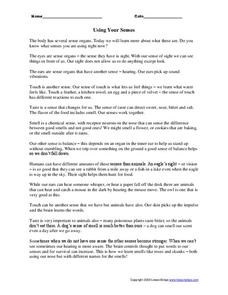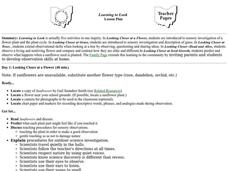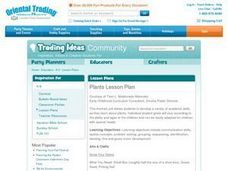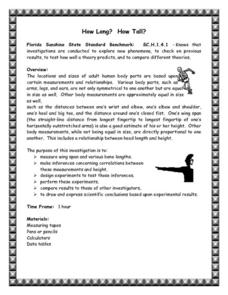Curated OER
Developing Environmental Awareness Through Problem Solving
Students examine the relationships among living and non-living parts of the environment. Using their senses, they identify the objects in their classroom. In groups, they participate in experiments to discover where electricity comes...
Curated OER
A Black Box Problem: How Do I Hear?
Learners assemble a diagram of the hearing pathway using information about its parts and their function, and predict the changes in hearing that might result from specific changes to the pathway.
Curated OER
Recovering the Romanovs
Students use DNA to solve an identity mystery. In this biology lesson, students use the Internet to gather information about sex-linked disorders and complete a Punnett square for hemophilia, then examine a handwriting analysis, ear...
Curated OER
My Crazy Contraption
Fourth graders design a contraption, which contains five different examples of simple machines and works without intervention. They sketch designs and label its parts. They present their creations to the class and relate them to Rube...
Curated OER
Science Drawing
In this drawing in science worksheet, students read about what is needed to complete a drawing in order to communicate ideas and discoveries in science. Students analyze a drawing of a volcano and indicate the problems with the drawing....
Curated OER
Monster Fun Learning the Five Senses
Learners explore the five senses. In this health lesson, students read the book Brave Little Monster and identify the five senses from the book. Learners draw an illustration from the book as a follow-up activity.
Curated OER
Beautiful Bovine
Students compare and contrast a human body to a cow. Using a diagram, they label and identify the functions of the cow's numerous parts. In groups, they create a Venn Diagram to compare the various types of cows with one another. They...
Curated OER
Using Your Senses
In this using your senses worksheet, students read a 1 page article on senses and then connect 6 body parts to their actual senses by drawing a line from one to the other.
Curated OER
I Belong to.....(The Senses)
In this neuroscience for kids worksheet, students identify whether each of the 20 body parts listed belongs to the eye, ear, nose, or mouth.
Curated OER
Humans
In this anatomy worksheet, students read a passage about the different parts of the human body. They then answer the 10 questions on the page.
Curated OER
My Five Senses
Students investigate the five senses. In this senses lesson, students explore the nervous system. Students examine how the body receives information through the five senses.
Curated OER
All About Me: My Senses
Students explore the world around them and identify their five senses and the parts of their bodies that are associated with each sense.
Curated OER
Waves
In this wave worksheet, students will review the characteristics of waves which includes the parts of a wave, how waves are measured, and how waves are created. This worksheet has 8 vocabulary used in a word puzzle, 5 true or false, and...
Curated OER
Archaeology For Kids Quiz 83
In this archaeology for kids quiz 83 learning exercise, students interactively answer 12 multiple choice questions about the history of money, as part of an online magazine.
Curated OER
Body
In this body instructional activity, learners answer short answer questions about the functions of basic body parts. Students complete 10 problems total.
Curated OER
Learning To Look
Sixth graders investigate a flower plant and the plant cycle. They extend observational skills when looking at a tree by observing, questioning and sharing ideas. They observe a living and nonliving flower and compare and contrast how...
Curated OER
"Ladybugs and Grasshoppers"
Students paricipate in number of activities related to ladybugs and grasshoppers.
Curated OER
Talking Tubes
Students study the theory that sound travels through a variety of instruments. They explore all the channels of the ear and its various purposes. Students test objects to see which ones were vibrating to make sound heard.
Curated OER
Plant Science Activities
Students complete several plant life activities. In this botany activity, students practice painting images that resemble plants they are familiar with as well as planting seeds outside of class. Students participate in a dramatic...
Curated OER
Kwanzaa Science
Students study the parts of a plant in order to better understand the muhindi as one of the seven symbols of Kwanzaa.
Curated OER
Hear The Light?
Students investigate a circuit and build a flashlight transmitter. In this electricity lesson, students are introduced to the parts of the modulated laser and define the purpose of each part. As an assessment, students construct a...
Curated OER
How Long? How Tall?
Seventh graders investigate the parts of the human body and examine the symmetry of body parts like arms and legs. They measure the body parts and take individual height and weight to compare the quantities. Student examine whether the...
Curated OER
Homology: Where Does The Evidence Lead
Learners are introduced to the topic of homology. In groups, they read a case study and compare different drawings of early vertebrate emryos. They work together to answer discussion questions and label the various parts of each embryo.
Other popular searches
- Ear Parts
- Earthworm Parts
- Ear Parts: Eardrum
- Ear Parts Eardrum
- Parts of the Earth
- Chicken Ear Parts
- Ear Parts Free
- Discover Parts of the Earth
- Human Ear Parts
- Ear Parts Free Lessons
- Ear Parts: Cochlea
- Ear Parts Cochlea

























